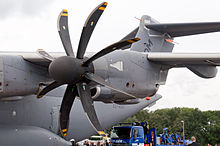EPI TP400

EPI TP400 is a completely new propeller turbine engine developed by the manufacturer consortium Europrop International for the military transport aircraft Airbus A400M . The abbreviation stands for Europrop International ( EPI ) and T urbo P rop. The full designation of the production version is TP400-D6 . The engine has an output of 11,000 shaft horsepower (8,203 kW ), making it one of the most powerful engines of its kind.
development
ITP , MTU Aero Engines , Rolls-Royce and Snecma Moteurs are involved in the development of this engine . The joint venture Europrop International was founded by the partner companies to develop, manufacture and support the TP400-D6.
The first run of the engine took place on October 28, 2005, approval was scheduled for mid-2008. Due to various problems (with the blisks , the propeller gear , " pumping " the high pressure compressor and the FADEC system) the approval was repeatedly delayed. The first flight on a modified C130W2 took place on December 17, 2008 from Cambridge Airport.
The successful maiden flight of the Airbus A400M equipped with four TP400-D6 engines took place on December 11, 2009 in Seville .
In May 2011, the European Aviation Safety Agency (EASA) granted approval for the TP400-D6 turboprop engine. This makes it the first military engine to be approved according to civilian standards.
In 2016, wear and tear on propeller gear units with a few hundred flight hours became known, which require unscheduled maintenance work during flight operations and impair the operational readiness of the A400M. The manufacturer Avio Aero would like to remedy this by replacing components and "adapting the gearbox" and received certification from EASA in July for an interim solution that extends the maintenance intervals.
Efficiency
The performance of the engine is only guaranteed worldwide by the relatively old Soviet engine Kuznetsov NK-12 (e.g. in the Antonow An-22 ) and the Ukrainian Ivtschenko Progress D-27 (installed in the Antonow An -22 ) developed by former Junkers experts around Ferdinand Brandner -70 ) exceeded. In contrast to the TP400, both engines have two propellers rotating in opposite directions.
Project manager
Rolls Royce
- High pressure compressor
- Low pressure wave
- Intermediate housing
- Engine mechanics (attachments)
- Engine integration
- Performance calculation
MTU
- Medium pressure compressor
- Medium pressure turbine and shaft
- Final assembly of all TP400-D6
- FADEC software
- Development and production tests
Snecma
- Combustion chamber
- High pressure turbine
- Starter
- Engine assembly on the aircraft
- Propeller gear (supplier: Avio Aero)
ITP
- Low pressure turbine
- Front housing
- jet
- Turbine housing
- External lines
Technical specifications
The engine is a three-shaft engine. The compressor achieves a total pressure ratio of 25: 1 and consists of a medium pressure compressor (five stages, pressure ratio 3.5: 1) and a high pressure compressor (six stages, pressure ratio 7: 1). The turbine is divided into a single-stage high- and medium-pressure turbine and a three-stage low-pressure turbine that drives the eight- blade variable pitch propeller FH386 from Ratier-Figeac via a reduction gear . This consists of composite materials and has the option of thrust reversal . The flanged propeller gearbox with a housing made of a magnesium alloy has a reduction ratio of 1: 9.929. Different gears are available for clockwise and anticlockwise rotating propellers, since use on the A400M requires different directions of rotation of the propellers.
| Parameter | Data |
|---|---|
| Engine type | 3-shaft turboprop |
| Shaft power | 8,203 kW (11,000 wave horsepower) at sea level |
| Max. Propeller speed | 864 min −1 |
| Max. Speed high pressure turbine | 18,396 min -1 |
| Max. Speed medium pressure turbine | 10,390 min -1 |
| Propeller diameter | 5,3 m / 8 sheets |
| length | 3.5 m |
| Dry matter | 1890 kg |
Web links
- Website of the manufacturer consortium Europrop International (English)
- EASA-TCDS type certificate of the TP400-D6 (PDF, English)
Individual evidence
- ↑ FlugRevue July 2011, p. 16, EASA approval for TP400
- ↑ Matthias Gebauer: Engine damage / A400M aircraft of the Bundeswehr have to stay on the ground. In: Spiegel Online . June 30, 2016. Retrieved November 29, 2016 .
- ↑ Matthias Gebauer: Engine problems with the A400M: Bundeswehr plans for an emergency. In: spiegel.de. Spiegel Online, May 12, 2016, accessed November 30, 2016 .
- ↑ Interim fix for A400M engine issue certified - Airbus. Reuters, July 10, 2016, accessed November 30, 2016 .
- ↑ Gerhard Hegmann: That is the unpredictable weak point of the A400M. In: Welt Online . April 1, 2016, accessed November 29, 2016 .

